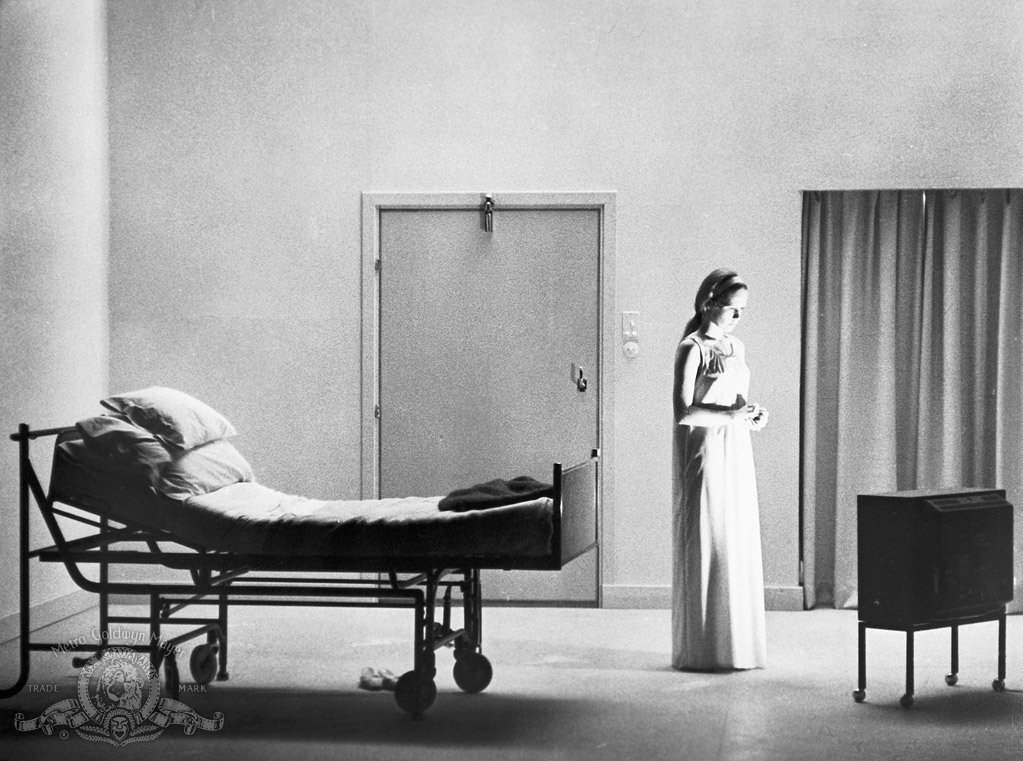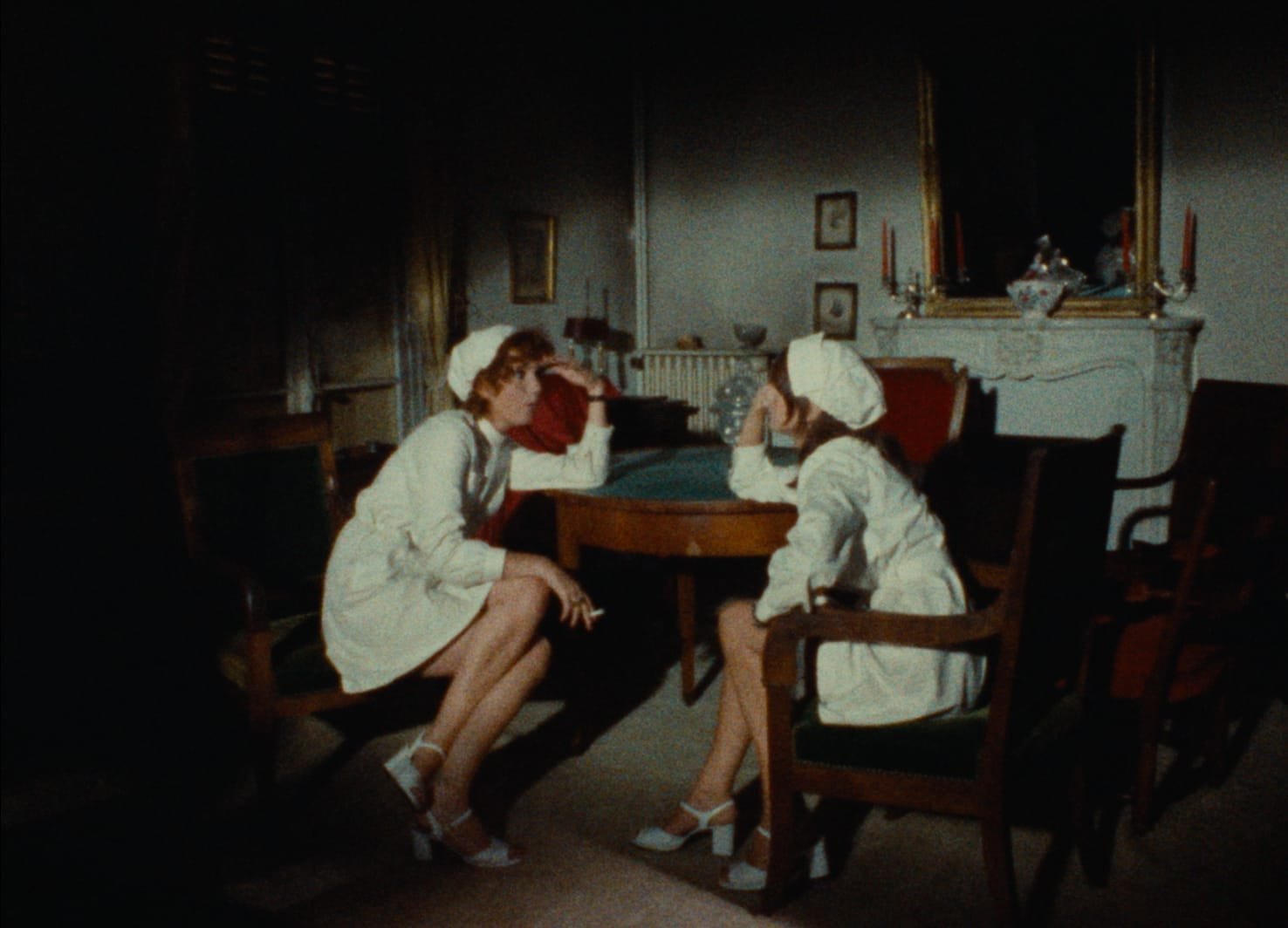TWICE TOLD TALES
A Review of “Persona” and its Remakes
By: Jo Rempel
Sitting across from journalist Marie Nyreröd, Ingmar Bergman begins to list off his demons. It’s the early aughts, and the Swedish auteur of the stage and cinema, now in his mid eighties, controls the interview.¹
One of his demons is “control”, naturally. Then there is laziness, rage, embarrassment, punctuality, resentfulness... He is afraid of everything.² It is a miracle he is able to produce a single project. “Now pan here!” He turns to face the camera directly; the shyness in this recitation has vanished. He flipped over the paper to show the two demons which he lacks. He has never experienced boredom, for one. Then, there is “the null demon. This is the case of my creativity or imagination abandoning me. That I am suddenly engulfed by silence and emptiness. There is nothing. This has never happened to me.”
As subtitles split one’s words in two, you could be listening to Bergman speak in Swedish as the English translation appears on screen. You will hear a strange rhyme with the final word spoken in his Persona (1966): “There is nothing”—ingenting—that is, there isn’t, save for the single ingenting which Alma (Liv Ullmann) manages to coax out of her mute patient Elisabet (Bibi Andersson) (setting aside for the moment whether any of Elisabet’s dialogue is within diegetic “reality”).
The way Persona begins its end is one last bizarre punchline. Alma constantly thinks she has heard something from Elisabet, but that has been too much: so why not try nothing. In Ingmar Bergman: Magician and Prophet, Marc Gervais refers to Persona as the beginning of Bergman’s “ingenting” period, in which the director has moved on from one subject (faith and existentialism) to one which is perhaps lesser (postmodernism’s “Derrida-da-da dance”).³ Despite frequent use of the italicized word, I somehow failed to pick up on its meaning: what I had thought to be emphasized so frequently I had construed a definition somewhere between “inventing” and the magician’s ingeniéur, the trick’s craftsman.⁴ Wild; unwitholding; multifarious; wheels within wheels appearing “from nothing”. How could the man who describes The Passion of Anna’s fade to white as “the very disintegration of the film image. Ingenting,” lead me astray?⁵
To put it simply, Persona and those works that follow it cannot truly represent nothingness. The corrosion of cinematic ideals does nothing to achieve this—less than nothing, in fact. The hazy wide shot on Max Von Sydow ending The Passion of Anna is a literal positive accumulation of light, leading us from existential ambiguity to a more transcendent kind. Among Persona’s tricks is the featuring of two separate takes of one of Alma’s monologues one after the other, each using either Alma or Elisabet as its sole visual subject. There is a controlled excess at hand—though we take for granted the ability to pause and rewind now, whether one could see a scene twice in a projected film is entirely up to the filmmaker. Did you catch that? Well, are you sure it happened that way? The film’s “dreamlike” aesthetics, which produce unmouthed whispers from Elisabet and an uncanny nurse/patient kinship within cinematographer Sven Nykvist’s stark naturalism, give us one guarantee: that there is more. On the fear and desperate passion of Bergman’s women, we may write whatever biography we like; but that is beside the point.⁶ Paul Schrader describes the film’s primary impact as being the very fact of its staying power: “before Persona, there was a sense that you could shrug off the nouvelle vague [....] And after Persona, it was very clear that you could not pretend that Persona did not exist.”⁷ Persona stands tall, mostly in proof of its own existence.
“Persona stands tall, mostly in proof of its own existence.”
To Schrader, Persona signs, seals, and delivers the French New Wave—can Persona successfully deliver itself? Would watching it be the same experience had its elements not become shorthand for the meeting of narrative and art cinema? Look at something like Barbet Schroeder’s Single White Female (1992), a film which for all intents and purposes is another entry in the early nineties erotic thriller boom. Both women speak; there is no sentient television set: while there’s both a glow and an obstinately ancient quality to Allie’s (Bridget Fonda) apartment, everything is firmly and equally “real”.
Jennifer Jason Leigh’s Hedy recreates Elisabet as a Jezebel figure, who before becoming a direct sexual threat to Allie’s relationship with her fiancé (Steven Weber) is a threat to Allie’s identity. For the yuppie owner of a fashion tech startup, this means a threat to her style. Same orange bob, same leather jacket: like a dagger to the heart. Yet there is the possibility that things aren’t so simple. Schroeder chooses to crib from Persona on a purely visual level once, during the opening titles, essentially creating a preface of unreality. Twin girls play dress-up opposite each other in the bathroom, one doing the other’s lipstick. At first we only see the one in closeup, doing her own. Then, as the original girl reaches over to her sister, the camera pans in unison. Once both are in frame it continues to move on its own. We pull back until it becomes clear that we were originally looking at a mirror image: once we’ve moved into a wide, there are now four girls, in two “shots,” the new original over the shoulder and the original duplicate in profile. As the intrigue around Hedy builds, this bleached-over shot will become not just “someone’s” memory but her own. Hedy’s twin died when she was still one of the preface’s two girls, but now Allie is beginning to take that place—though again, the method is far less magical. Hedy commits a couple of murders (the boyfriend, Sam, is a comical accident) before dying by prolonged strangulation in Allie’s self-defense. As Allie delivers the closing narration, Schroeder leaves the door to dreamland open a crack: “every day, I try to forgive Hedy for Sam. Then I try to do what she couldn’t: forgive myself.” At these last two words the camera has panned from a close-up on a box of Hedy’s memorabilia Allie’s putting away, to a photograph of the two of them, spliced together down the middle. Persona’s uncanny unison of Ullmann and Andersson is recalled, this time as the “picture of the picture”. In her striving to grieve better, Allie has finally, genuinely, let Hedy in.

“What has remained is that stories come from positions of silence”.
Single White Female is useful for my purposes particularly because it does the least “ingenting” of any film that has “remade” Persona over the years—next to Black Swan, which while attempting far more ends up astonishingly literal. Schroeder was himself a producer on Jacques Rivette’s Céline and Julie Go Boating (1974), in which the titular women (Juliet Berto and Dominique Labourier) take turns participating in, forgetting, then remembering/viewing a domestic melodrama reenacted every day in a mysterious mansion. At the end of each day, a young girl is mysteriously smothered to death, and by entering the mansion in unison, the two conspire to rescue her from the story, from narrative into ingenting. Still, the film’s ending recapitulates its opening, only with Céline chasing after Julie this time. It is not the repetition itself that is bad, we are told; it is simply that some who perpetuate have no clue how to play.
So while Céline and Julie may be forces of instability, their joint motivation is essentially to keep things “their way”. Stubbornness as the source of their conflict: consider the ambiguity of Elisabet’s muteness, how her doctor (Margaretha Krook) assumes it is solely an act of will; or the letter of hers which Alma reads, expressing how she never wants to leave her nurse’s care. Lars Von Trier’s Melancholia (2011) draws upon this dynamic of desire and disability, where Justine’s (Kirsten Dunst) depression puts her in her sister, Claire’s (Charlotte Gainsbourg) care, yet her self-assured facing of the world’s destruction grants her a clairvoyance. Friction occurs when two people both want different nothings—there’s an inescapable truth, that a story will occur whenever the fantastic ideal that two women can occupy the same room comes to fruition.⁸ Robert Altman, who had ingented twice with Images (1972) and 3 Women (1977), puts Persona’s inspirational power “from the fact that one woman talked and the other didn’t, more than anything else.”⁹ The silence has never been literally reproduced by those following Persona, including Altman himself. What has remained is that stories come from positions of silence, like that of an accused murderess in Saint Omer (2022) whose testimony does not speak the same language as the French courts. Stories emerge within the lacunae formed between demands—stories which, while not necessarily “our own”, refuse not to be heard, and require nothing at all.
¹ Marie Nyreröd, “Bergman Unpublished: Demons,” The Ingmar Bergman Foundation, December 20, 2018, video, 14:18, https://www.youtube.com/watch?v=4pf5P4zzOfw.
² That an artist would say something along these lines is hardly unique. Bergman is unique in enumerating these fears with covetous control.
³ Marc Gervais, “Ingenting ... or Almost,” in Ingmar Bergman: Magician and prophet (Montréal, QC: McGill-Queens University Press, 1999), 88-113.
⁴ French for “engineer” and only used this way in Christopher Nolan’s The Prestige (2006)—once you watch a film three times it has to be real in one way or another.
⁵Gervais, 110.
⁶See Peter Ohlin’s coverage of the “lack of interpretive” clarity among Persona’s many critics with regards to how Alma reacts to the picture of a Jewish boy rounded up by a Nazi soldier. Peter Ohlin, “The Holocaust in Ingmar Bergman’s ‘Persona’: The Instability of Imagery,” Scandinavian Studies 77, no. 2 (2005): 241–74, http://www.jstor.org/stable/40920587.
⁷“Paul Schrader on PERSONA,” The Criterion Collection, 2013, video, 11:01, https://www.criterionchannel.com/videos/paul-schrader-on-persona.
⁸ While I haven’t been tackling psychoanalytic readings of Persona and its descendants explicitly, with regards to this idea of “friction” I’m indebted to Jacqueline Rose’s writings on sexual difference and its determinant role in the cinematic apparatus. Jacqueline Rose, “The Field of Vision,” in Sexuality in the Field of Vision (London: Verso, 2020), 165-234.
⁹ Robert Altman, Altman on Altman, ed. David Thompson (London: Faber & Faber, 2005), 71.



